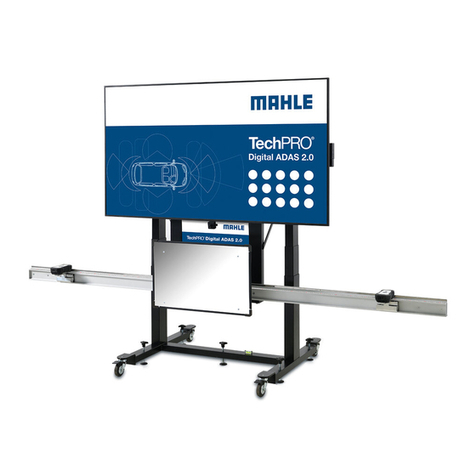© MAHLE
6 | ACX1281 | Important notesen
2.4 Safety regulations
2.4.1 ACX1281
Always carefully study and follow all the safety regulations before
using the MAHLE product.
Avoid all skin contact with the refrigerant. The low
boiling point of the refrigerant (approx. –30°C) can
lead to frostbite. Should refrigerant come into con-
tact with the skin, remove any moistened clothing
immediately and rinse the area of skin affected with
generous amounts of water.
yAvoid all skin contact with the UV dye. Should UV dye come
into contact with the skin, remove any moistened clothing
immediately and rinse the area of skin affected with generous
amounts of water.
yR1234yf is colorless, with weak characteristic smell and
heavier than air. It may flow into repair pits. Should refrigerant
escape, provide for sufficient ventilation (particularly in repair
pits) and leave the workshop.
Never inhale refrigerant, dye and oil vapors. The
vapors can irritate the eyes, nose and respiratory
system. If liquid refrigerant or UV dye comes into
contact with the eyes, rinse them thoroughly with
water for 15 minutes. Then obtain medical attention
even if no pain is felt.
yNever swallow UV dye. Should it be swallowed inadvertently,
never attempt to induce vomiting. Drink generous amounts of
water and obtain medical attention.
yBefore connecting the ACX1281 to a vehicle air conditioning
system or an external refrigerant bottle, make sure the quick-
release couplings are not leaking. Only ever use external
refrigerant bottles provided with safety valves and certified
inline with the applicable standards.
yBefore switching off the ACX1281, make sure all charging
and drainage operations have been completed. This prevents
damage to the unit and reduces risk of refrigerant escaping
into the environment.
Never use compressed air with R1234yf. Certain mix-
tures of air and R1234yf are highly flammable. Such
mixtures are a potential hazard and may lead to fire or
explosions and thus cause damage or injury.
yRefrigerant extracted from a vehicle air conditioning system
may be contaminated with moisture, lubricant, dirt and traces
of other gases.
yThe ACX1281 is provided with a refrigerant identification system
designed to prevent contamination with other refrigerants.
yIf the refrigerant has been contaminated by being mixed with
other gases, remove the contaminated refrigerant and add
fresh R1234yf before using the ACX1281 for A/C service.
yR1234yf is not to be used in areas in which there is a danger
of explosion. Fire, open flames and smoking are prohibited.
Welding and soldering are not permitted.
yThe ACX1281 unit should not be exposed to excess moisture
or be operated in wet areas.
yHigh temperatures and UV radiation may chemically separate
R1234yf. The resultant products can cause coughing and
nausea.
yR1234yf is not to be mixed with other refrigerants. The mix-
ing of refrigerants could damage the vehicle air conditioning
system.
If high-voltage components or high-voltage wires are
handled incorrectly, there is a risk of fatal injury from
high voltage and the possible transmission of current
through the body.
yDe-energizing is only to be performed by a qualified electri-
cian, a qualified electrician for specific tasks (hybrid) or a
power systems engineer.
yWork on vehicles with high-voltage components is only ever
to be performed in a safe, de-energized condition by persons
with the minimum qualification "Trained to perform electrical
work".
yEven after deactivating a high-voltage vehicle electrical sys-
tem, the high-voltage battery may still be live.
yOperating condition cannot be established from any running
noise, as the electric machine is silent when stationary.
yIn gear positions "P" and "N" the engine or electric motor
may start spontaneously depending on the charge of the
high-voltage battery.
yNever open or damage high-voltage batteries.
yOn vehicles that have been in an accident, never touch high-
voltage components or exposed high-voltage wires before
deactivating the high-voltage vehicle electrical system.
yThe ACX1281 must be constantly monitored when in opera-
tion. Never leave the ACX1281 unattended when in operation.
yVehicle A/C service using the ACX1281 must be prepared and
implemented such that the vehicle air conditioning system
circuit does not have to be opened (for example by removing
the radiator or engine).






























